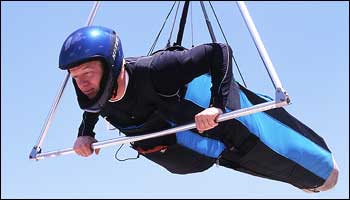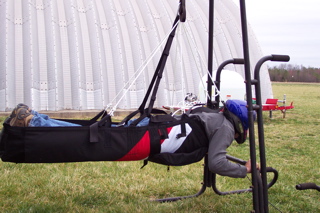There are three major types of hang gliding harnesses - the knee hanger-trainer, the cocoon, and the pod harness. The knee hanger-training harness is often used by hang gliding schools in the initial training phase of a hang glider pilot. The pod is usually the harness that one first purchases after training. The cocoon is often used by expert hang glider pilots in free-style flight mauneuvers.
Knee hangers require to put your legs "through the top". This entry harness is a simple design that affords the maximum amount of leg movement. It is light so it is especially appropriate to the training site. Since, there are many older used knee hanger harnesses, the torso portion of the harness may or may not have continuous webbing that runs through the leg loops and across the shoulders. The main hang webbing attached to the hips runs upward to the carabiner which attaches to the hang straps on the hang glider. The shoulders are supported by lines running from the carabiner. There is also a pulley on the carbiner with lines running from the leg straps to the torso. Since a beginning foot-launch student pilot does not use the basetube to mauneuver, the knee hanger portion of harness is often removed or disengaged so not to cause inadvertant rotations during training. However, at the appropriate time in training, the knee hanger portion can be engaged. Since the knee straps are already attached at launch, the pilot simply has to run and rotate downward toward the basetube to become prone (like superman). Here's knee hanger in action.

Although it is entirely possible to use a knee hanger harness in recreational flight, most pilots agree there are much more comfortable, and versatile harnessess. Therefore, once you graduated from the training school, an upgrade to the pod harness is very smart. However, it is great to own one for the times you need to go to the training hill for development of skills (like when you purchase your new glider).

The pod harness has been found to be the most comfortable and versatile harness even though it is the heaviest and most restrictive. The pod harness is designed to totally encase the the pilot from feet to chest to provide support, warmth, and storage space. Modern pod harnesses are front or side entry types. A combination of zipper and redundant buckles provide for the structural integrity and ease of entry and exit. The most distinquishing characteristic of the pod is the "insect" look the leg portion provides when the pilots leg are out of the bag in preparation for launching. The pilot launches and throws the legs into the base of the leg portion of the harness. The harness has a line operated zipper that the pilot engages when airborne, one string for zipping up at the start of the flight and one string to unzip for landing. Because the enclosed space of the leg bag/boot and surface area of the rest of harness there is much room for pockets of various size and storage areas for glider bags, radios, water containers, etc. This is the most versatile and comfortable type harness and is used by majority of recreational pilots. Some designs are made extremely aerodynamic for competition use and others are aimed at the recreational cruiser pilot. These pod harnesses, trying to remove parasitic drag, only use one main suspension line from the pilots center of gravity on the lower back, making them trickier to get upright for landing. Some recreational designs use longtitudinal rods that distribute the vertical tension of pilots weight away from the body. Despite these variations, the main support should still be from the continuous webbing running from the pilots legs and around the shoulders. This would provide the maximum security in the event of a parachute deployment or other high G mauneuver.

The cocoon can described as a pod - with no zipper entry port for the legs - in which the top longitudinal half has been removed. The lower half, where the legs lie, is folded up in front of the pilots torso for launch. Often, the teeth are used to hold a string the keeps this lower half up and out of the way during the launch. The legs are cocked sideways and foot put into the boot after launch to get the legs into the harness. This foot-launch complexity, no doubt, made the pod more popular. The cocoon harness was a natural step from the knee hanger but has been mostly replaced by the pod for recreational and competition use. The cocoon, however, provides much more support then the knee hangar and still provides the flexibility to move the body for extreme control movements. These exaggerated movements are often used in free-style hang gliding where high angles bank and pitch are changing constantly. Cocoons are often used in tandem-tow flights for the student-passenger because they have provide comfort require no special skill when launching and landing in a prone position
The same structural recommendations apply to the cocoon regarding continous webbing.
| Glider Data | Harness Information | Accessory Information | Equipment Packages |